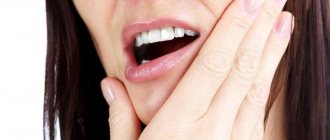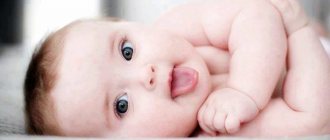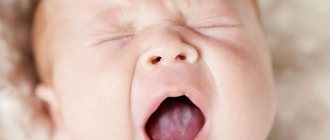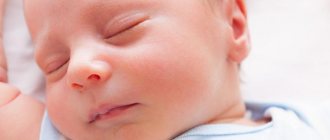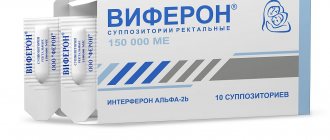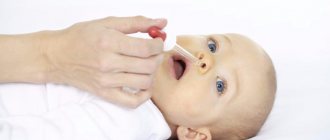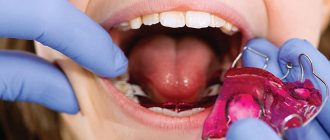The birth of a baby is always a joy for young parents. Naturally, all the attention of the mother and father is focused on the child. They can't get enough of how well he eats, sleeps and smiles back at them.
- Causes of lower lip tremor in babies
- Complications and consequences of tremor
- What measures should be taken if a baby’s lower lip is shaking?
But when the baby starts crying and the parents notice their lips trembling, they become alarmed. Therefore, we will look at why a newborn’s lower lip is shaking.
Causes of lower lip tremor in babies
Often mothers notice that their child’s lower lip shakes when the baby is at rest. And here the parents begin to panic. The thought immediately pops into their head that their little one is seriously ill with something.
Tremor is a shaking associated with involuntary contraction of the mental, triangular and quadratus muscles of the lower lip. Now let's look at the reasons for the formation of tremors from the norm and pathology.
- Response to stimuli (cold, stress, loud sound, sudden influx of bright light).
- When a newborn is stressed, an uncontrolled amount of norepinephrine is released from the adrenal cortex, which enters the bloodstream. NA causes vasospasm and contraction of smooth muscle tissue.
- An underdeveloped central nervous system is unable to regulate the baby's movements.
Among the stressful situations why a newborn's lower lip shakes, one can highlight: bathing, intestinal colic (pain), the moment of changing clothes, a state of hunger, and ordinary fatigue.
- Involuntary muscle contraction at rest.
- Joint trembling of the chin and lower lip, limbs, head.
- Frequently recurring tremors.
- After three months of age, trembling becomes more frequent.
The causes of pathological tremor are:
- prematurity (in premature children, trembling is observed up to 1.5-2 years);
- stress during pregnancy;
- developmental disorder of the peripheral nervous system (PNS);
- increased ICP (intracranial pressure);
- increased blood sugar in a newborn;
- maternal diabetes mellitus or impaired glucose tolerance during pregnancy;
- birth trauma (long, protracted labor; injury received when the head passes through the birth canal);
- Polyhydramnios, infections during pregnancy and a deficiency of essential microelements and vitamins (in particular Mg and B vitamins) can cause disruption in the development of the central nervous system (hereinafter referred to as the CNS) of the fetus.
Types of nervous tics in children
Each child has his own individuality, and therefore nervous tics that arise for one reason or another are different.
Tic manifestations generally have two types:
- Motor (motor). They are detected by spasms of individual muscles, their groups or movement of limbs and other parts of the body.
- Voice (vocal). They can be recognized in the form of frequently repeated individual sounds, syllables, exclamations, words and even phrases.
Both groups are divided into simple and complex tics. Everything is clear here. A simple form - one short movement or sound, a complex one - several muscle groups are involved, if there are vocal disorders, progress is also observed in them.
Complications and consequences of tremor
Physiological tremor does not pose any danger to the health of an infant. After 3-4 months after birth, trembling of the chin and lower lip disappears and no longer bothers either the child or his parents.
As for pathological tremor, here things are much more complicated. Prolonged and frequently recurring tremor is the first alarm bell indicating neuropathy. Involuntary contraction of the muscles of the chin, lips, upper and lower extremities, and head may indicate the presence of perinatal encephalopathy in the baby.
This pathology may include various disorders of the central nervous system that arise as a result of intrauterine development. If you consult a doctor in a timely manner, the disease can still be treated.
If the tremor of the lips and chin is not caused by neurology, then it is necessary to undergo a set of examinations to determine whether there is a deficiency of Ca and Mg in the baby’s body, and diabetes mellitus.
Main manifestations
Localization of tic movements most often occurs in the facial or neck muscles. Over time, they can spread from top to bottom. The most common examples of simple childhood motor tics are:
- frowning;
- blinking;
- squinting;
- moving the wings of the nose;
- drawing in air through the nose;
- twitching of the corner of the mouth;
- turning or tilting the head;
- shrug;
- flinching;
- twitching of limbs;
- flexion or extension of fingers;
- snapping fingers.
Vocal tics are manifested by coughing, throat sounds, sniffling, spoken syllables or exclamations. This is a meaningless sound that interferes with speech and gives the impression of stuttering or stuttering. If no measures are taken to eliminate them, the situation will only get worse. Tic movements also progress and reach a new level in the form of:
- grimace;
- head tossing;
- touching various parts of the body with hands;
- contractions of the abdominal muscles or diaphragm;
- squats;
- bouncing.
All of the above nervous tics in children are not all manifestations of the disease. They can be individual and atypical. It all depends on the child’s level of development, his character and temperament, sensitivity to environmental stimuli and a number of other reasons.
What measures should be taken if a baby’s lower lip is shaking?
Above we discussed why a newborn’s lower lip shakes. Now let’s look at how parents should act in such a situation. When a pathological tremor has been identified in an infant, a neurologist will treat it.
When an infant’s lower lip and chin shake under stress, you need to do the following:
- Do not panic and do not jump near the baby shouting “Oh!” and “Ay!” The baby needs to create a cozy and comfortable environment. Better yet, kiss the little one!
- Get rid of the cause of stress (turn off the music, turn off too bright lights).
- If you have the opportunity to breastfeed your baby, then you need to continue in the same spirit. No mixtures!
- Control your sleep patterns. Feeding, sleeping, and waking the child should take place at the scheduled time.
- Walk with your baby in the fresh air for at least 3 hours.
- Pay attention to the baby's clothing. It should not allow the child to overheat.
- Feel free to harden your baby by wiping him with a towel.
- Massage.
After visiting a neurologist, you may be prescribed a relaxing massage and sea salt baths. The massage procedure can be carried out either in a clinic with a massage therapist or at home.
The massage itself should not last more than 10 minutes.
Knowing all this, you shouldn't panic. If you are concerned about tremor of the baby's lower lip, contact your local pediatrician, who will prescribe an examination if necessary.
www.preobrazhenie.ru - Transfiguration Clinic - anonymous consultations, diagnosis and treatment of diseases of higher nervous activity.
- If you have questions for the consultant, ask him via a personal message or use the “ask a question” form on the pages of our website.
You can also contact us by phone:
- 8 495-632-00-65 Multichannel
- 8 800-200-01-09 Calls within Russia are free
Your question will not remain unanswered!
We were the first and remain the best!
CREATE NEW MESSAGE.
But you are an unauthorized user.
If you have registered previously, then “log in” (login form in the upper right part of the site). If this is your first time here, please register.
If you register, you will be able to further track responses to your messages and continue the dialogue on interesting topics with other users and consultants. In addition, registration will allow you to conduct private correspondence with consultants and other users of the site.
Any unusual behavior of a baby frightens young parents. When a newborn's lower lip trembles, they may panic. After all, he is so small and vulnerable. How to understand what is happening to him? The first thought that appears is that the child is cold. The mother takes the child in her arms and tries to warm him up. In the mother's arms, the baby often calms down, and his lips stop trembling. But there are times when a baby’s chin shakes in a warm room and in the mother’s arms. It is difficult for parents to find an explanation for this. This means that something is wrong with the baby and he is sick. Is this condition a sign of a disease?
Prevention
The main preventive measures come down to pregnancy planning and preliminary treatment of diseases of the expectant mother. Together with giving up bad habits and a calm lifestyle, they help prevent lip shaking.
If a newborn exhibits a symptom, it is necessary to create an environment in which he will be protected from a surge of strong positive or negative emotions.
To do this you need:
- maintain a daily routine and take frequent walks;
- protect the child from bright lights and loud sounds;
- surround it with a cozy and calm atmosphere;
- continue breastfeeding, but do not apply to the breast when the mother is in an excited state;
- carry out preparations for walks and hygiene procedures calmly;
- Give your child a massage to relieve muscle hypertonicity.
If a newborn's lower lip or chin often shakes, massage will help calm him down and relieve tension. Contact of
the newborn's skin with the mother's skin, gentle stroking, carrying the baby in a kangaroo, soothing warm baths help reduce the severity of the symptom and reduce the newborn's reaction to irritants.
Physiological causes of chin tremors in infants
Trembling (tremor) of the chin is often observed in very tiny children. Typically, a newborn's lower lip will quiver when he is excited, cries a lot, is very upset, or is in pain. At this moment, his arms or legs may also tremble.
The cause of this condition is usually the imperfection of the baby’s nervous and endocrine systems. When he is scared or angry, his adrenal glands produce stress hormones - adrenaline and norepinephrine. The baby’s adrenal glands have not yet adjusted their work, so more hormones are produced than necessary. Excess hormones literally burn the baby's muscles, causing them to contract. But this condition passes quickly enough as soon as the baby calms down. Therefore, the tremor often disappears after the mother takes the child in her arms. The baby is calmed by contact with his mother's body.
Most children develop trembling of the chin or lips in the first months of life. It is considered normal for tremors to appear after prolonged crying, physical activity or emotional overexcitation. A baby may become overexcited after playing for a long time or due to a prolonged lack of sleep.
But why does a newborn's lip tremble when he is calm?
Muscle hypertonicity
Sometimes a baby's shaky chin appears even when he is calm. The cause of this phenomenon may be muscle hypertonicity. This is a limitation of the voluntary motor function of the infant, caused by certain disorders in the development of the brain and peripheral nerve. With hypertonicity, the baby's muscles are overstrained. They remain tense even when the baby is in a relaxed state.
Other signs of hypertonicity are poor quality sleep (the baby sleeps little and poorly), increased irritability, frequent regurgitation after feeding, throwing back the head and unnatural arching of the body.
If you suspect hypertonicity, you can conduct an experiment. You need to take the baby under the armpits and place him on a hard surface, slightly tilting him forward. In this position, babies begin to instinctively move their legs, as when walking. A baby with hypertonicity will stand on his toes, while a healthy baby will stand on his entire foot. This is a classic diagnostic sign of hypertension and dysfunction of the nervous system.
General concept of ticks
This is the most popular pathology of the children's nervous system at an early age. It is simply impossible not to visually notice the manifestation of a tic, although some parents manage to go for weeks or even months without seeing any oddities in their child’s behavior.
Tics are involuntary, stereotypically repetitive, sudden or jerky movements that are the result of spontaneous contraction of individual muscles or groups of muscles.
At the initial stage of development of the disorder, attacks occur quite rarely, and repetitive movements do not cause much concern or problems. The child can even restrain or control them. However, attempts to control the tic cause him:
- internal discomfort;
- feeling of anxiety;
- mental stress.
When control over oneself weakens, tic manifestations occur, and the baby immediately receives obvious relief.
Nervous tics in children are usually detected between the ages of two and fifteen years. In the period of 6–8 years, tic hyperkinesis most often develops, while at 14–15, in approximately half of the cases it disappears spontaneously.
Fun fact: Boys are five times more likely to have the disorder than girls. From a scientific point of view, this is explained by the more stable psyche of female representatives.
Other reasons
Muscle tremors often accompany in the first months of life those babies who suffered from oxygen starvation in the womb.
Oxygen starvation of the fetus is called hypoxia. It occurs when placental abruption, entanglement with the umbilical cord, in the event of a threat of miscarriage, or due to other disorders of placental blood flow. Fetal hypoxia can be caused by infectious diseases, polyhydramnios, or bleeding. Lack of oxygen affects brain development and causes tremors in children.
Chin trembling often affects children whose mothers were in a state of nervous tension during pregnancy. During pregnancy, a woman's body produces a lot of stress hormones. They penetrated the placenta and entered the baby’s blood. Maternal stress hormones could cause disturbances in the functioning of the child’s nervous and endocrine systems.
When should tremors be treated?
As a rule, lip trembling in most children goes away on its own by the age of three months. If at 3 months the baby continues to suffer from tremors, he may have developmental pathologies. A particularly alarming sign is tremor of the limbs and head, which does not weaken over time, but even intensifies. This indicates a clear neurological disorder.
This condition may indicate that the child has hypocalcemia, hyperglycemia, hypomagnesemia, sepsis, intracranial hemorrhage, or increased intracranial pressure. Therefore, the baby urgently needs to be shown to a neurologist.
It is also recommended to consult a neurologist if there is a suspicion of hypertension in the baby.
In addition to drug treatment, the doctor will prescribe therapeutic exercises and massage. Swimming is very beneficial for all children with tremors and other manifestations of nervous disorders. You can visit the baby pool or organize swims at home in the bathroom. Such procedures have an excellent effect on the baby’s nervous system and muscle tone. At home, you need to create a comfortable, calm and peaceful environment for your child.
Treatment
Conservative therapy
Therapeutic tactics are determined by the nature of the underlying pathology, the symptom of which is trembling. Some conditions, such as neonatal tremor, go away on their own and do not require medical intervention; in other situations, specialized care is necessary. Usually the emphasis is on complex drug correction:
- Etiotropic.
It is possible to eliminate the infectious causes of trembling with antibacterial and antiviral drugs. To reduce the severity of hyperbilirubinemia in newborns, tinmesoporphyrin is used. Elimination of drug-induced parkinsonism is achieved by transferring the patient to atypical antipsychotics. - Pathogenetic.
In the treatment of hypoxic-ischemic disorders, vasoactive agents (vinpocetine, pentoxifylline), antihypoxants and antioxidants are used. In case of hydrocephalus, diuretics (furosemide, mannitol) can be used to reduce the production and improve the outflow of cerebrospinal fluid; for intracranial hemorrhages, hemostatic therapy is indicated. - Symptomatic.
Treatment of parkinsonian tremor is carried out with levodopa, dopamine receptor agonists (pramipexole). Neuroleptic tremors are treated with amantadine and anticholinergics (trihexyphenidyl). In cases of severe familial tremor, beta blockers (atenolol, sotalol) are used; in resistant cases, botulinum toxin injections are used.
The traditional method of treating kernicterus is phototherapy, if it is ineffective, exchange blood transfusion is practiced. The consequences of perinatal damage to the nervous system and cerebral palsy require complex neurorehabilitation - with physiotherapy (myostimulation, electrophoresis, reflexology), massage, exercise therapy. Special devices (orthoses) are used, and children are recommended to work with a speech therapist or psychologist.

